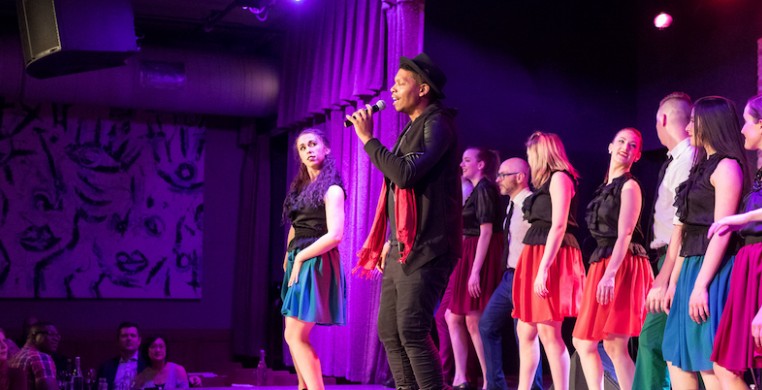You might expect to enjoy live jazz and a glass of locally brewed beer or wine at City Winery, but add tap dancing to the mix and you have an unlikely, if happy, pairing with the chic vibe of this West Randolph Street bar, restaurant and performance venue.
Chicago Tap Theatre’s unique blend of live jazz and tap drew a capacity crowd to City Winery this past Sunday for the second annual installment of “Sweet Tap Chicago,” the company’s cabaret program.
Chicago Tap Theatre (CTT), now in its 16th anniversary year, distinguishes itself as the only tap company in Chicago (and one of very few anywhere) that dramatizes original, full-length stories through tap dance, complete with plot, characters, scenery, narration, and original, live music.
“Sweet Tap Chicago” gives audiences a different take on the company’s talents in a more conventional concert format of unrelated tap and music numbers, with choreography by founding artistic director Mark Yonally, rehearsal director Kirsten Uttich, former company dancer Rich Ashworth, and collaborating company dancers. Each piece is introduced by engaging co-MC/vocalists Taylor Mallory and JC Brooks. This year’s two-set program featured new works and previous repertory inspired or set to music by Chicago artists, like Buddy Guy, Chance The Rapper, Sam Cooke, and Smashing Pumpkins.
City Winery’s airy lobby welcomes patrons into an inviting, brick-walled entry. Glass panels partition discreet seating areas for drinking, eating, entertainment, and, as was the case yesterday, all three.
The dusky-lit, two-tiered cabaret room features huge abstract murals across one long wall and rows of tables and chairs jammed together for maximum seating capacity. Votive candles flickering across table tops cast just enough light to read the menu, which offers everything from snacks to a casual meal and drinks. Music stands, a keyboard, drum-kit and amplifiers, crammed onto an improbably tiny thrust stage at the far end of the room, are flanked by two large video screens.
As fun and novel as it is to watch dance in such a cool setting, obstacles present some technical issues. Sitting toward the back of the first level sipping a cappuccino and waiting for the concert to begin, I puzzled over impossible sightlines and wondered how dancers would even fit on the stage, much less move in its cramped confines. What’s more, from where I sat, it would be nigh impossible to see their feet, a rather crucial factor when it comes to tap. Repositioning my chair into the aisle behind our table gave me a workable, if not ideal, view of the stage, but I had to really stretch my neck to see the stage floor.
The clip-clop of tap shoes clattered into the darkened room like a small herd of ponies trotting across the house center aisle and began the rhythmic ostenato of a time step toward the stage. Musicians filed to their onstage posts, and the electricity of movement and music ignited.
Video monitors proved helpful when detailed footwork demanded extra focus. Surprisingly, the dancers managed to pack every inch of stage space with full-body movement, despite the cramped quarters, but I still missed the expansiveness a full-size proscenium stage affords, and a clear shot at seeing tapping feet first-hand. The compensation was the closeness of dancers and musicians, necessarily breathing down each other’s necks, which generated its own special chemistry.
At its best, “Sweet Tap Chicago” pushes the aesthetic of live jazz music and tap dance ever closer to a true integration of visual and audible rhythm, melody, spatial design, and vocals. Towards that end, Yonally has staged musicians and singers into the choreography to great effect whenever possible. This worked spectacularly well in Yonally’s “The Beat Goes On,” and his finale to Set 1, “Move On Up/Touch The Sky.” In both pieces, The acoustic precision and play between the tapping and music director Kurt Schweitz’s instrumental orchestration created a musically sophisticated blend of physical and auditory rhythmic design across disciplines. In “Move On Up,” a fun rhythmic oneupmanship with the musicians, each of the four dancers took riffs with Corbin Andrick’s wailing sax, Bob Parlier’s drums, Schweitz’s bass, and Elisa Carlson’s keyboard. Yonally’s musical subdivision of beats is a footwork phenom, combining artistic sensibility with technical skill in standout improv.
Yonally’s tactile precision, along with that of Jennifer Yonally and Kirsten Uttich, mitigated against a sometimes disturbing sound imbalance between an over-amplified tap floor and the instrumental music. In some of the full ensemble work, rhythmic coordination between the two ensembles muddied under the thunderous sound of heavy hooves. Hopefully that imbalance was rectified for the evening performance, but it’s something to watch, especially in the group work of newer ensemble dancers, each of whom proved charming and skilled individually.
In a program comprised of many pieces strung together like beads, diversity makes the program where sameness of genre can be numbing. “Sweet Tap Chicago” managed to change it up often enough to sustain its momentum with the creativity of stand-out numbers like Ashworth’s whimsical trio, “A Song of Great Social and Political Import,” superbly danced a cappella by Heather Latakas, Chris Matthews and Case Prime. Here dancers accompanied their tapping with the syncopated tones of spoons tapping on whiskey bottles.
Mark and Jennifer Yonally’s love duet, “Chicago That Toddlin’ Town;” Mark’s spectacular improv solo, “With Apologies to Sonny Rollins," and the three singers and five dancers in his “Bring It On Home;” and Uttich’s “Superstar” homage to Bob Fosse each added diversity of style and theatrics that contributed significantly to the strength of an overall immensely entertaining program.


